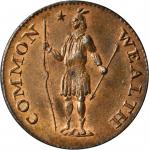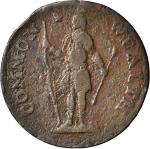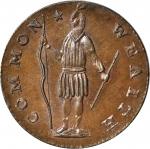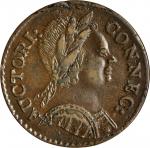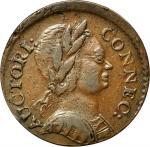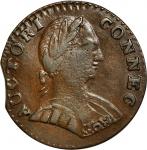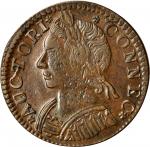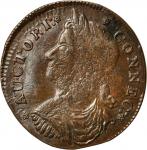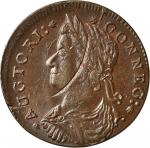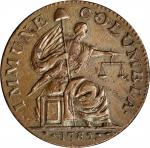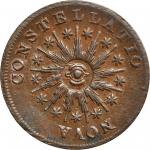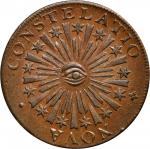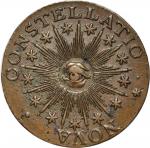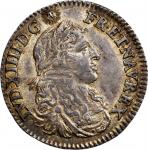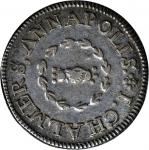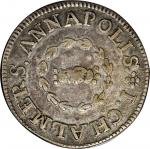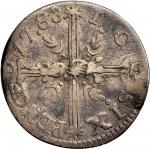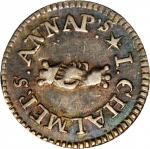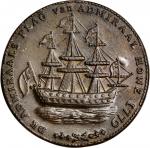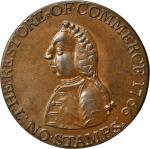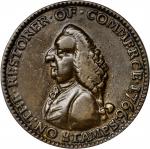1785 Confederatio Copper. Small Circle. W-5635. AU-53 (PCGS).146.7 grains. A marvelous example of this important historic rarity. The surfaces are mostly hard, smooth, and glossy, with light chocolate brown toning over both sides. The reverse is bold and essentially unflawed, with only trivial planchet gaps in the lower left field and a minuscule rim nick right of the date. The die edge is visible atop that side, above NFEDERAT. On the obverse, some natural planchet texture remains unobliterated, primarily at center left, not corrosion but just the face of the unstruck planchet showing itself after striking. All design elements are bold, and denticles frame that side from 11:00 to 6:00. The visual appeal is superb, and the color and surfaces bespeak great originality.<p>No design better summarizes the attitude of post-Revolutionary America than this one: America as a native warrior placing a Liberty cap on the Altar of Liberty while crushing the British crown underfoot within a peripheral legend INIMICA TYRANNIS AMERICANA or America, Enemy of Tyrants.<p>While Taxay attributes authorship of this design concept to Robert Morris, it undoubtedly came instead from Morris’ co-author of the tract Taxay cites: <em>Propositions respecting the coinage of gold, silver, and copper</em>. That piece was published in 1785, based on the May 13, 1785 report of the grand committee of the Continental Congress. The primary authors were Morris, who gave voice to his proposal that evolved into the Nova Constellatio patterns, and Thomas Jefferson, who preferred a competing decimal structure that ended up winning out in the long run. Pages 1 through 6 of the report, as published, were signed by Morris. Pages 9 through 12 were noted as including “NOTES on the Establishment of a MONEY MINT, and of a COINAGE for the UNITED STATES. By Mr. Jefferson.” But pages 7 and 8 were unsigned, the work of the committee. Most of these pages were dominated by what was essentially a single long math problem. The bottom of page 8 featured an argument for a minute basic denomination — a Morris argument — and a final paragraph that read: <p>“Lastly, as to the names above chosen, they, like all other names, are arbitrary, and better may perhaps be substituted. The word crown occurred from the following idea of an impression for the gold coin — An Indian, his right foot on a crown, a bow in his left-hand, in his right-hand thirteen arrows; and the inscription MANUS INIMICA TYRANNIS.” <p>It should be pointed out that the design concept was patterned after the seal of the Commonwealth of Virginia. Committee member Thomas Jefferson ended his term as governor of Virginia ten and a half months before the committee read its report. <p>Julian P. Boyd, editor of Volume 7 of <em>The Papers of Thomas Jefferson</em>, noted in a footnote that the paragraph in question came from a manuscript in the hand of Gouverneur Morris and was accompanied by a sketch by him of the reverse of this coin: 13 individual stars composing a single radiant starburst surrounded by the words CONFEDERATIO and 1785. Though the obverse design was surely Jefferson’s, rich with the Virginian anti-monarchic spirit he turned into prose in the Declaration of Independence, the conversion of this design from concept to physical coin was perhaps the work of Gouverneur Morris, who was also one of the three partners on the Nova Constellatio coinage to which this is linked by die tree.<p>The VIPs who received one of these coins were probably largely composed of red-letter names known to schoolkids, but evidently they didn’t think much of them, as most of these coppers were simply spent. The number produced must have been tiny, as only eight examples of this variety are confirmed today. Another seven of the Large Circle reverse are recorded, bringing the total for the type to 15 pieces. Most are well worn, a significant proportion are corroded from ground exposure, and only one is Mint State. Only four from these dies have been graded by PCGS: two in the VF range, this one at AU-53, and an AU-58 last sold at auction in 1987. This example has not been offered at auction since 1976; before then, it had been off the market since the 19th century and had spent most of its history in the collection of the Massachusetts Historical Society, which consigned it to the 1976 sale.<p>There are very few examples of this iconic rarity. Fewer are nice. This is one of the nice ones, and it deserves a focal place in a world class cabinet.PCGS Population: 1, 1 finer (AU-58).From the Archangel Collection. Earlier, from Stack’s 1976 American Numismatic Association sale, August 1976, lot 109; the William Sumner Appleton Collection, to the collection of the Massachusetts Historical Society by bequest in 1905.

